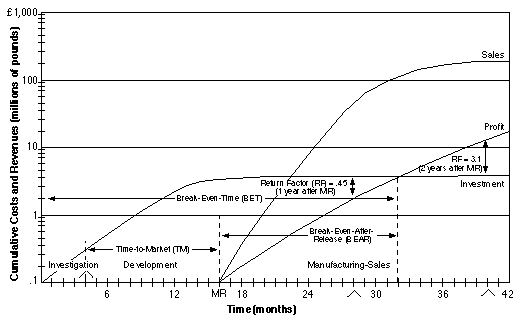The Hewlett-Packard Return Map

The Return Map is intended to be used by all of the functional managers on the new product introduction business team. It is basically a two dimensional graph displaying time and money on the x and y axes respectively.
Time is drawn as a linear scale while money is more effectively drawn on a logarithmic scale, because for successful products the difference between sales and investment costs will be greater than 100:1.
It is important to remember that money amount are shown rising cumulatively.
The time axis is divided into three parts:
- Investigation,
- Development, and
- Manufacturing and Sales.
Investigation
The purpose of Investigation is to determine the desired product features, the product's cost and price, the feasibility of the proposed technologies, and the plan for product development and introduction. At this point all numbers are estimates. Investigation is usually the responsibility of a small team and requires a relatively modest investment. At the end of Investigation, the company commits to develop a product with specific features using agreed-upon technologies.
Development
The development phase is usually the primary domain of R&D; in consultation with manufacturing; its purpose is to determine how to produce the product at the desired price.
Manufacturing Release
The formal end of the development phase is Manufacturing Release (MR) - that is, when the company commits to manufacture and sell the product. When the product is ready to be manufactured and shipped to customers, sales become a reality and manufacturing, marketing, sales costs and profits are finally more than estimates.
New Metrics
The map tracks - in money and months - R&D; and manufacturing investment, sales, and profit. At the same time, it provides the context for new metrics:
- Break-Even-Time,
- Time-to-Market,
- Break-Even-After-Release, and
- the Return Factor.









